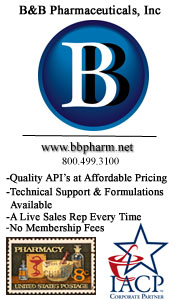|
|
| Letter from the Editor |
| News |
| IJPC now on Facebook |
| Did You Know? |
| Tip of the Week |
| Looking Back |
| PCAB Accreditations |
|
| |
|
|
To place a classified advertisement please contact: Lauren Bernick lbernick@ijpc.com or 405-513-4236 |
| |
|
|
|
|
| |
|
|
|
|
| |
|
|
|
|
| |
 |
| |
 |
| |
|
|
 |
| |
 Letter from the Editor Letter from the Editor |
|
Editorial: Is Just One List Feasible? Part I
This is the eleventh in our series presenting various aspects of the new H.R. 3204, the Drug Quality and Security Act (DQSA). This week, we will introduce the feasibility of having only one list of drug substances; those that should not be used in compounding, while the remaining substances may be used.
As previously discussed in this newsletter, there will be a "negative" list and a "positive" list developed by the FDA with recommendations from the Pharmacy Compounding Advisory Committee. Actually, there will practically be three lists, not two, that result, as follows:
- negative list
- positive list
- all others list
The "all others" list may include some of the following, and these will be discussed in more detail next week:
- Pre-1938 drugs that have never been FDA-approved with no official monographs
- Drug substances considered but not accepted for the positive list
- Investigational/study drug substances
- Orphan drugs
- OTC drugs with no official monographs.
- Herbals/Some Dietary and Nutritional Supplements with no official monographs
- Others
Some of these may be okay to use with allowances, but this should be clarified. We will discuss these further next week.
Also, next week we will discuss the use of only a "negative" list based on the premise that if a drug should not be used in compounding, it should be on the negative list; all others should be available for meeting physician and patient needs. This will require the development of only one list and include a complete FDA review of substances that should not be in the marketplace, either manufactured or compounded.
Loyd V. Allen, Jr., PhD, RPh
Editor-in-Chief
International Journal of Pharmaceutical Compounding
Remington: The Science and Practice of Pharmacy Twenty-second edition
|
| |
| News |
|
FDA Reports 140 Potential Drug Shortages Averted
In the first 9 months of 2013, the FDA reported to Congress that that CDER helped prevent 140 potential new drug shortages. With the FDA Safety and Innovation Act, the FDA receives reports from industry before they occur and can formulate approaches to prevent or address them.
http://www.in-pharmatechnologist.com/Regulatory-Safety/FDA-shortage-mitigation-measures-working-thanks-to-drugmakers
Drug Shortages Still Problematic to Physicians
Today's most acute shortage is basic IV fluids. Despite efforts and some success by the Administration to ease shortages of critical drugs, shortfalls have persisted, forcing practitioners to ration and, in some cases, to scramble for alternatives.
Generic versions of sterile injectable drugs are among the most critical; due in part because the factories making them are aging and prone to quality problems. The GAO has concluded that the FDA is preventing many more new shortages now than in the past, but the total number of shortages has continued to grow.
Manufacturers are now required to alert the agency of potential shortages before they happen, and the FDA has some options. For example, in some cases where particles were found to be contaminating a drug that was in short supply, the Agency allowed the company to filter the drug to avoid disrupting supplies instead of shutting down the production line altogether.
http://www.nytimes.com/2014/02/11/health/shortages-of-critical-drugs-continue-to-vex-doctors-study-finds.html?_r=0
New Drug Shortages Decline
The GAO reported 456 drug shortages in 2012. Adverse effects include prolonged duration of a disease, permanent injury, and even death resulting from drug shortages. The new law requires manufacturers to give the FDA six months' notice if they plan to discontinue drugs or halt production. The FDA can also expedite approvals of new drugs that can replace medicines in shortage.
http://www.bloomberg.com/news/2014-02-10/new-drug-shortages-decline-in-u-s-on-greater-scrutiny.html
|
| |
| IJPC Now on Facebook |
|
Become a fan of the IJPC Facebook page and share ideas, photos, and keep up to date with the latest compounding information -
http://www.facebook.com/IJPCompounding
|
| |
| Did You Know ... |
|
�that Saint Valentine's Day, also known as Valentine's Day or the Feast of Saint Valentine, is observed on February 14 each year in many countries throughout the world? Even though it is celebrated, it is not a holiday and remains a working day for most countries.
|
| |
| Tip of the Week |
|
Need some nice artwork for Valentine's Day, go to:
https://www.google.com/search?q=valentines+day&tbm=isch&tbo=u
|
| |
| Looking Back |
|
Remember this
And you'll be spared,
Trains don't whistle
Because they're scared!
Burma Shave
|
| |
| Accreditations |
|
PCAB is proud to announce the accreditation of the following pharmacies:
Doc Lane's Veterinary Pharmacy, LLC, Lexington, Kentucky; Anne Gresham, RPh, anne@doclanes.com. Initial Accreditation for Sterile & Nonsterile Compounding
Boothwyn Pharmacy, Inc., Boothwyn, Pennsylvania; Steve Gianelos, CPhT, steve.gianelos@bpi-rx.com. Initial Accreditation for Sterile & Nonsterile Compounding
Hotze Pharmacy, Katy, Texas; Kimberly Haddock, RPh, kim.haddock@hotzepharmacy.com. Re-accreditation for Nonsterile Compounding
Compounding Docs, Inc., Boca Raton, Florida; Martha Little, PharmD, Martha@compoundingdocs.com. Initial Accreditation for Sterile & Nonsterile Compounding
|
|




